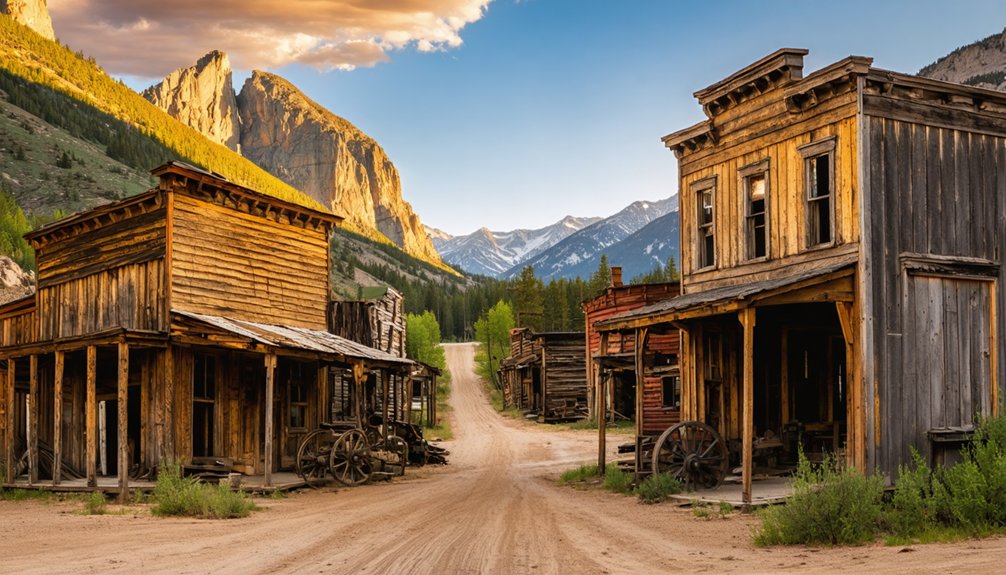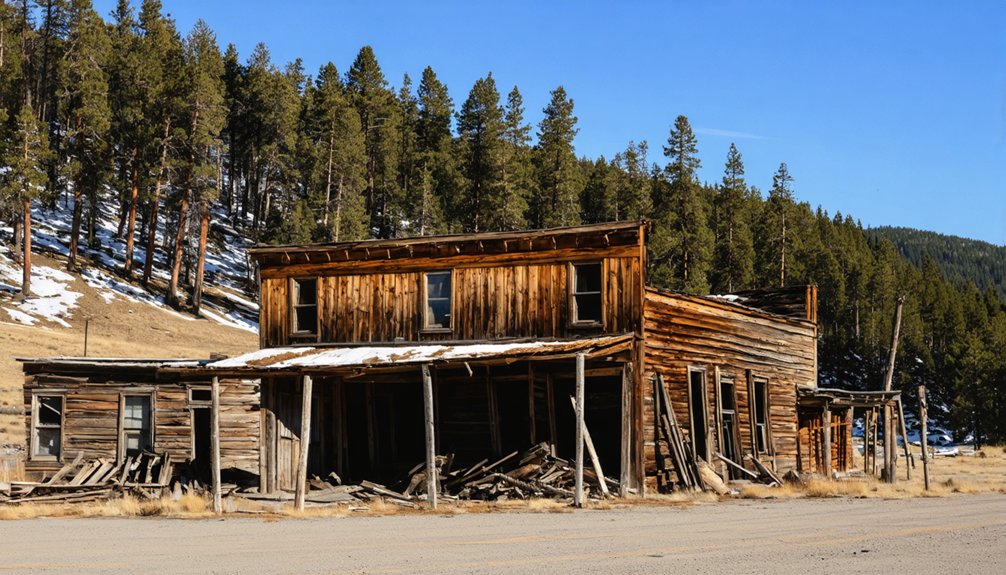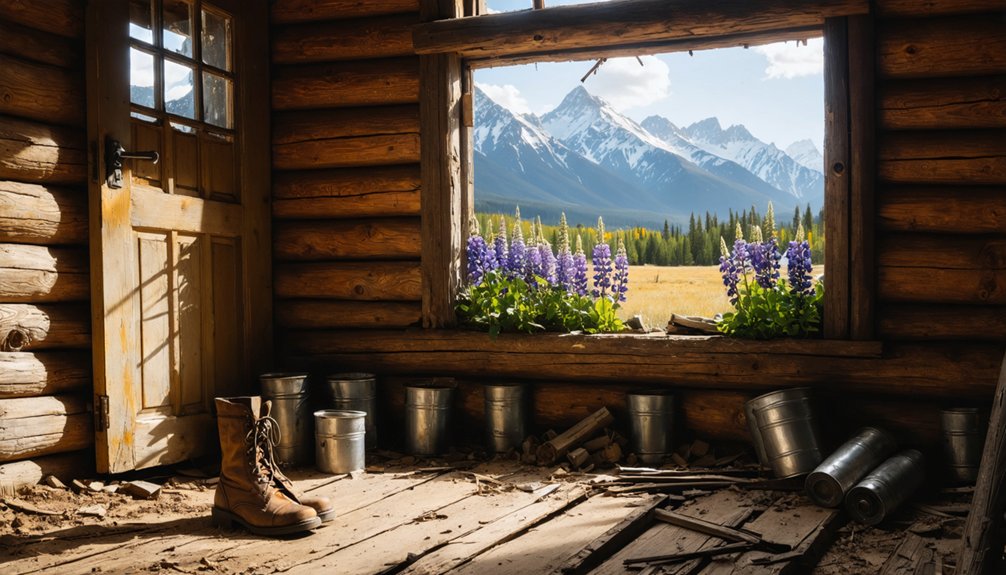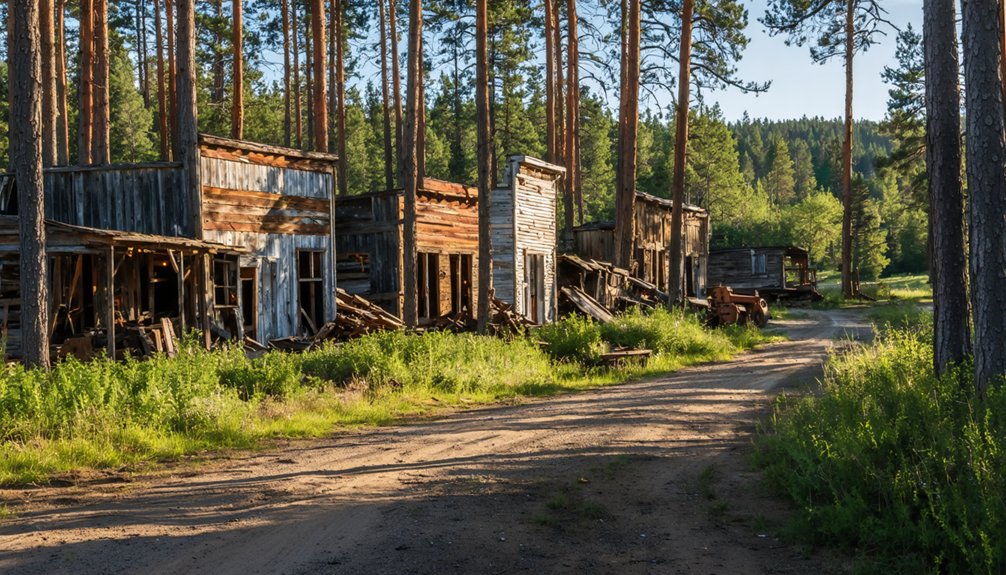You’ll find Rocky Bar nestled in Idaho’s rugged mountains, where miners extracted over $6 million in gold during the 1860s. This once-bustling town of 2,500 residents boasted 80 arastras, multiple stamp mills, and served as Alturas County’s seat from 1864 to 1882. After a devastating fire in 1892, the town gradually declined, though its well-preserved Masonic Hall and jail still stand. The site’s rich history holds countless tales of resilient pioneers and forgotten fortunes.
Key Takeaways
- Rocky Bar was a thriving gold mining town established in 1863 that reached a peak population of 2,500 residents in 1864.
- The town produced over $6 million in gold during the late 1800s, with miners extracting 2-10 ounces per ton.
- A devastating fire in 1892 significantly impacted the town’s recovery, contributing to its eventual decline into a ghost town.
- Today, visitors can explore preserved structures including the 1892 Masonic Hall and historic town jail.
- Located eight miles from the nearest paved road, Rocky Bar is maintained by a small group of caretakers focused on historical preservation.
The Birth of a Mining Frontier
While the discovery of gold across Idaho Territory sparked numerous mining rushes in the 1860s, Rocky Bar’s story began specifically in 1863 when prospectors traced placer deposits along Feather River to rich quartz leads at Bear Creek.
You’ll find evidence that Spanish-speaking early miners worked these grounds even before the official discovery, using traditional arastros to process ore near what became known as Spanishtown.
Despite challenging terrain and no proper roads, word spread quickly of Rocky Bar’s potential. By May 1863, you’d have seen 1,500 Boise Basin miners flooding the area, enthusiastic to stake their claims.
The mining technology was basic at first – with about 80 arastros grinding ore by 1864 – but the promise of both placer and lode deposits kept prospectors coming.
The completion of the South Boise Toll Road in 1864 brought unprecedented growth to the settlement.
The settlement’s rapid growth and strategic location led to Rocky Bar being seriously considered as a potential Idaho Territory capital in its early years.
Gold Rush Glory Days
When you’d have arrived in Rocky Bar during its 1864 peak, you’d have found a bustling frontier town of over 2,500 people, complete with stamp mills thundering day and night.
You’d have witnessed prospectors extracting gold at impressive rates – from 2 to 10 ounces per ton – while eighty arrastras and multiple stamp mills processed ore from the rich veins.
The completion of the South Boise Toll Road transformed Rocky Bar into the region’s most important settlement, spurring rapid construction of mills and infrastructure that reflected the sudden wealth pouring into the area.
Mining Boom Transforms Town
After gold was discovered along the Feather River in December 1863, Rocky Bar exploded into existence as one of Idaho Territory’s most promising mining settlements.
You’d have witnessed a remarkable transformation as mining technology evolved from simple arastras to sophisticated stamp mills by 1865, processing precious gold and silver from the area’s rich lode mines.
The town’s cultural diversity would’ve caught your eye, with Chinese, Spanish, and Mexican miners working alongside others, all contributing to Rocky Bar’s rapid growth. Many small homes, built by Chinese workers, dotted the growing town’s landscape.
As the population swelled to 2,500, rivaling Boise itself, you’d have found a bustling community complete with hotels, saloons, and businesses.
The town’s prosperity and strategic location in the Sawtooth Mountains even made it a serious contender for the territorial capital.
Today, visitors can explore the well-preserved remnants that offer fascinating insights into the town’s mining past.
Prospectors Strike It Rich
The discovery of gold along the Feather River in 1863 sparked an unprecedented rush to the South Boise diggings, where prospectors found their fortunes in Rocky Bar’s rich mineral deposits.
As word spread of promising quartz leads near Bear Creek, about 1,500 miners left the Boise Basin, drawn by specimens of rich ore and dreams of striking it rich.
You’d have found the early placer mining incredibly profitable, with over 100,000 ounces of gold recovered around Bear Creek alone – worth about $2,000,000 at $20 per ounce.
The ore’s quality was exceptional, yielding 2 to 10 ounces per ton, with primitive mills managing 70-80% recovery rates.
Life in the Mountain Mining Town

Life in Rocky Bar demanded exceptional fortitude from its 2,500 residents, who carved out an existence in this remote mountain mining town during its 1864 peak.
You’d find a diverse community here, from Spanish-speaking miners working their arrastras to Chinese settlers along Steel Creek, all facing daily challenges of mountain isolation together.
The town’s beating heart was its mining economy, where you’d pay dearly for supplies – freight costs could run 30 cents per pound from Omaha.
Despite the hardships, you’d find the essentials of frontier life: saloons, warehouses, and the bustle of freight wagons along the South Boise Toll Road.
The community’s resilience showed in their response to setbacks, like rebuilding after the devastating 1892 fire that nearly destroyed the town.
The remarkable story of Peg Leg Annie surviving a fierce blizzard while trying to reach Rocky Bar exemplifies the determination of its hardy pioneers.
From Boomtown to Ghost Town
Despite Rocky Bar’s meteoric rise to prominence in 1864, when its population of 2,500 rivaled Boise’s, the town’s trajectory would mirror countless other mining settlements across the American West.
You’ll find the town’s cultural impact began to wane as economic shifts took their toll – ore deposits became less profitable, and miners sought their fortunes elsewhere.
The devastating fire of 1892 struck a harsh blow, and though residents rebuilt, the town’s decline continued steadily.
Before its decline, Rocky Bar served as the county seat of Alturas from 1864 to 1882.
Mining operations dwindled, and families gradually abandoned their mountain home. The once-bustling Chinese settlement along Steel Creek disappeared entirely.
By the late twentieth century, only Charles Sprittles remained as the last year-round resident.
Today, you’ll discover just a handful of seasonal residents among the haunting remnants of Rocky Bar’s glory days.
Historical Structures and Landmarks

While Rocky Bar’s early development centered around mining operations, its physical infrastructure quickly expanded to include sophisticated industrial and civic structures.
You’ll find evidence of this growth in the historical architecture of buildings like the wooden courthouse built in 1866-1867 and the combined general store, post office, and Masonic Hall rebuilt by George Golden in 1892.
The town’s mining infrastructure was impressive, featuring seven stamp mills including a twelve-stamp facility that could process up to 100 tons of ore daily.
Rocky Bar’s industrial might shone through its seven stamp mills, with one massive facility processing 100 tons of ore each day.
Along the rivers, Chinese workers built homes, while Spanish and Mexican miners established Spanishtown nearby, using traditional arastras for ore processing.
Today, only a handful of these structures remain, though the old post office’s interior survives at Boise’s State Historical Museum.
Among the few surviving structures is the rustic cabin where Peg Leg Annie lived and conducted her bootlegging operations during Prohibition.
Notable Characters and Local Legends
Among Rocky Bar’s most fascinating residents was Peg Leg Annie, who embodied the town’s frontier spirit after losing her legs in a blizzard rescue. She’d later sell whiskey, guarding her stock with a shotgun and demanding payment upfront – a reflection of the town’s mix of grit and entrepreneurship.
You’ll find other notable characters woven into Rocky Bar’s cultural heritage, like George Golden, who rebuilt and operated the Masonic Lodge as a multipurpose community hub in 1892. Today visitors can travel 45 miles north from Mountain Home to explore these historic remnants.
Charles Sprittles, the town’s last year-round resident, left a legacy of oral history through his son George Albert.
Local folklore includes tales of early Spanish miners at nearby Spanishtown, adding layers of mining legends to the community’s resilience.
These stories, passed down through generations, paint a vivid picture of Rocky Bar’s diverse frontier society.
Exploring Rocky Bar Today

When you visit Rocky Bar today, you’ll find well-preserved structures like the 1892 Masonic Hall and town jail standing as evidence to the area’s mining heritage.
Heritage tourism helps support the preservation of this historic site, drawing visitors from around the world.
The town produced over 6 million in gold during its heyday in the late 1800s.
You’ll need to navigate gravel roads about eight miles from the nearest paved surface to reach this remote ghost town at 5,269 feet elevation in the Sawtooth Mountains.
While the town no longer maintains its boom-era population, a small group of caretakers helps preserve these historic buildings, welcoming visitors who want to explore this piece of Idaho’s gold mining past.
Remnants of Mining Life
As you explore Rocky Bar today, you’ll discover fascinating remnants of its mining heyday scattered throughout the landscape.
Mining technology from the 1860s still dots the terrain, including remnants of 80 arastras and abandoned stamp mills that once crushed valuable quartz ore. Cultural artifacts tell stories of a diverse frontier community that rivaled Boise’s size, with a population of 2,500 during its peak.
- The historic Masonic Hall, rebuilt in 1892, stands as a symbol of the town’s civic life, serving multiple roles from lodge to post office.
- Preserved mining tunnels and shafts, some reaching 700 feet deep, reveal the ambitious scale of historic operations.
- Hidden traces of Chinese workers’ homes and Spanishtown’s mining ruins reflect the multicultural fabric of this frontier boomtown.
Remote Access Adventures
Today’s journey to Rocky Bar offers intrepid explorers a genuine ghost town adventure deep in Idaho’s remote wilderness.
You’ll navigate challenging gravel roads, winding 65 miles northeast from Mountain Home through the rugged Sawtooth Mountains to reach this historic mining settlement.
Before tackling the remote terrain, careful adventure planning is essential. Pack appropriate gear and supplies, as you’ll be far from modern conveniences.
The journey rewards you with stunning mountain vistas and opportunities for hiking, fishing, and four-wheeling.
While exploring the town’s remnants, you’ll encounter the infamous warning sign – a symbol of the area’s untamed character.
Remember to check road conditions before departure, as seasonal changes can affect accessibility.
Despite the challenges, Rocky Bar’s isolation preserves its authentic ghost town atmosphere and connection to Idaho’s gold rush heritage.
Small Community Persists
Despite its near-total abandonment, Rocky Bar maintains a tenuous hold on existence through a handful of dedicated residents who’ve chosen to make this remote ghost town their home.
You’ll find a striking example of community resilience here, where preservation challenges haven’t deterred these few inhabitants from safeguarding what remains of this historic mining settlement.
Living in Rocky Bar means embracing a distinctly rustic lifestyle:
- You’ll need to be self-sufficient, as there are no stores, services, or modern utilities
- You’re looking at significant travel time to reach basic amenities in Featherville or Mountain Home
- You’re joining an informal community focused on historical preservation rather than typical neighborhood life
These determined residents represent the last thread of continuity in a town that once bustled with over 2,500 people during its 1800s mining heyday.
Frequently Asked Questions
What Wildlife and Predators Should Visitors Be Aware of in Rocky Bar?
Like shadows in the wilderness, you’ll need wildlife safety awareness for black bears, mountain lions, wolves, and coyotes. Watch for rattlesnakes in rocky areas. Predator awareness includes carrying bear spray.
Are There Any Camping or Overnight Accommodation Options Near Rocky Bar?
You’ll find several camping facilities nearby, including Willow Creek Transfer Campground and East Fork Recreation Site. While there aren’t formal overnight rentals, you can pitch tents or park RVs at designated sites.
What Is the Best Season to Visit Rocky Bar?
You’ll find the best weather and ideal conditions from late spring through early fall, when dry roads enable access and temperatures support hiking, wildlife viewing, and exploring historic structures comfortably.
Can Metal Detectors Be Used to Search for Artifacts?
Like a time capsule awaiting discovery, you can’t use metal detectors here without proper permissions. Metal detecting techniques must follow strict artifact preservation laws to protect historically significant sites.
Are There Any Guided Tours Available of the Ghost Town?
Yes, you’ll find guided tour options that showcase the historical significance of the town’s mining past. These tours are best available during summer and fall when weather conditions are ideal.
References
- https://www.idahoheritagetrust.org/projects-grants/rocky-bar-masonic-hall/
- https://authorkevinkelley.com/2014/07/21/rocky-bar-ghost-town-idaho/
- https://westernmininghistory.com/towns/idaho/rocky-bar/
- https://idahonews.com/news/idaho-photo-galleries/gallery/ghost-town-idaho-rocky-bar
- https://www.ghosttowns.com/states/id/rockybar.html
- https://www.rickjust.com/blog/a-very-ghosty-ghost-town
- https://en.wikipedia.org/wiki/Rocky_Bar
- https://kids.kiddle.co/Rocky_Bar
- https://www.idahogoldmining.com/claims-for-sale/rocky-bar/
- https://history.idaho.gov/wp-content/uploads/2018/12/0167.pdf



